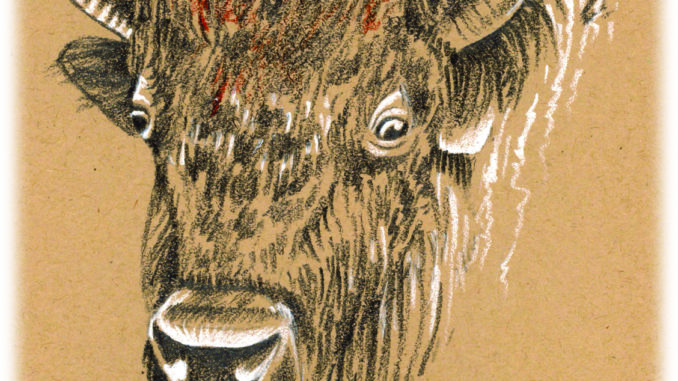
By Gary Raham
When I set up the spotting scope this year at the south parking lot in preparation for another talk about the wild bison herd at Soapstone Prairie Natural Area in northeastern Larimer County, the animals walked into the field of view, as if they were ready to reveal all. Actually, seeing the bison when you talk about them can be a rare event. Even dozens of massive grass munchers tend to disappear on their thousand acres of real estate, especially when they dip into an arroyo. But people still come to listen and to learn. That’s fitting. Humans have helped shape the bison during and after the last ice age. They nearly destroyed them in one frantic instant in the 19th century. And today humans are reintroducing them to a prairie that bison can help remake and rebuild.
On June 29, Dr. Jennifer Barfield brought the City of Fort Collins’ Master Naturalists up to date on the herd. She called it her “Creating the bison 2.0 talk.” Barfield was instrumental in using Assisted Reproductive Techniques (ART) to use the genetically pure Yellowstone bison herd stock and eliminate the potentially harmful Brucellosis disease-causing organism in order to bring bison back to Northern Colorado in 2015.
Lots of bison still roam in the United States—somewhere on the order of a half a million—but most of those are bred for commerce of some kind. The National Bison Association (https://bisoncentral.com/current-status/) says sales of bison meat last year topped $350 million. Bison can still turn grass into meat quite efficiently as they have done for tens of thousands of years on this continent. Only about 20,000 animals are managed for conservation—a legacy of government action and some perceptive farmers and ranchers who sent samplings of scarce remnant bison at the beginning of the 20th century to Yellowstone National Park. (See https://www.wcs.org/our-work/species/bison and https://www.nps.gov/yell/learn/nature/bison.htm)
The ART techniques used to liberate embryos and/or semen from Brucellosis bacteria are fairly straight forward, utilizing technology often used to assist human reproduction. The embryos of infected female bison pass through a series of “washes” with increasingly dilute solutions of trypsin, an enzyme that can digest the bacterium. Semen from infected males can be washed in a similar fashion. The sperm and eggs of dead animals can also be harvested, washed, combined to create an embryo and then implanted into a surrogate animal to give birth. The first calf born this latter way arrived May 12, 2017.
Although there is a vaccine for Brucellosis, it is not 100% effective. Researchers must test bison blood for the presence of the bacterium and periods of quarantine are sometimes required to insure animals are Brucellosis free. More bison not suitable for the genetically pure herd could be relocated rather than sold for meat if more quarantine facilities were available. Brucellosis now is largely restricted to the Yellowstone area and, although farmers worry about bison transmitting the disease to cattle, elk are the primary way Brucellosis sometimes gets into cattle herds near Yellowstone.
Barfield is excited about the possibility of moving into Phase II of the bison project, which will include an expansion of the enclosure north and adjacent to the south parking lot and existing visitor trails. They currently need $20,000 to finish the fencing and would be happy to hear from any potential donors. The herd now numbers 33 and the enlarged parcel of prairie could support up to 100 animals before they would need to export some to other areas.
Colorado State researchers are also conducting ongoing ecological studies to determine how the bison are impacting the prairie ecosystem today. Although graduate student Kate Wilkins, who has been working on this project, will graduate in November, hopefully others will continue the research, funding permitting.
Bison wandered the North American plains in numbers beyond counting for hundreds of thousands of years, morphing from heavy-horned beasts that gathered in circles to ward off Ice Age cats and dire wolves to smaller, more agile creatures when two-legged primates ran after them, killing from a distance. Those same primates nearly wiped them from the Earth during the 1850s and ’60s, but hesitated just in time to save them from oblivion. We naturalists-at-large on Soapstone Prairie will tell you these stories and more—most of them true—in various programs outlined in Tracks and Trails magazine on the City of Fort Collins website. (http://www.fcgov.com/naturalareas/)
Saturday, August 19, from 9-11 a.m., learn about “Soapstone Treasures: the bison archaeology connection.” Thursday, September 7, from 4-6 p.m., hear the “Story of the American Bison.” Perhaps the herd will wander into the field of view again and help tell their own tales of a developing future on the northern Great Plains of Colorado.
For background on the bison herd, see “Wild is back” (November, 2014) and “Bison still stir our imagination and respect” (June, 2016) in the North Forty News archives (https://northfortynews.com).
Support Northern Colorado Journalism
Show your support for North Forty News by helping us produce more content. It's a kind and simple gesture that will help us continue to bring more content to you.
BONUS - Donors get a link in their receipt to sign up for our once-per-week instant text messaging alert. Get your e-copy of North Forty News the moment it is released!
Click to Donate
